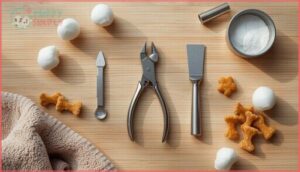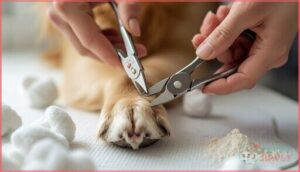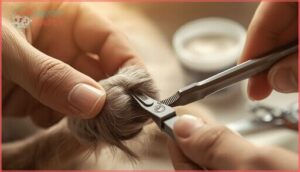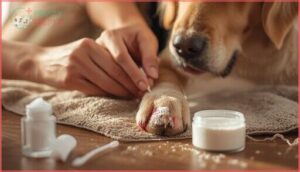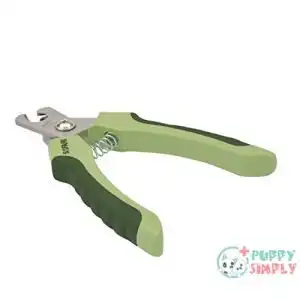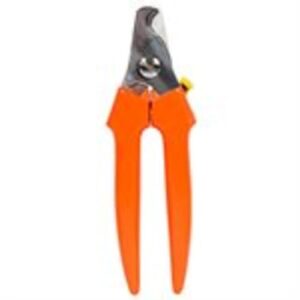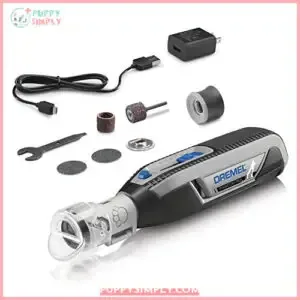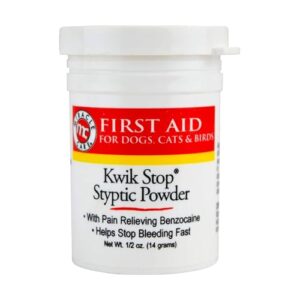This site is supported by our readers. We may earn a commission, at no cost to you, if you purchase through links.
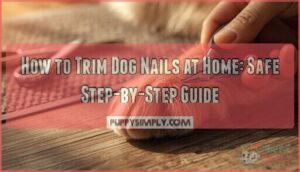
Your dog’s nails clicking across the hardwood floor might sound harmless, but those overgrown nails are quietly wreaking havoc on your pet’s body. Each step on long nails forces your dog’s toes to splay unnaturally, straining joints and tendons in ways that can lead to chronic pain and mobility problems down the road.
Many pet owners avoid dog nail trimming because they’re worried about hurting their furry friend, but leaving nails untrimmed actually causes more harm. The good news is that with the right tools and technique, you can safely trim your dog’s nails without stress or bleeding.
Once you understand basic nail anatomy and follow a few simple steps, home nail care becomes a quick routine that keeps your dog comfortable and healthy.
Table Of Contents
- Key Takeaways
- Why Trimming Dog Nails is Essential
- Key Tools Needed for Home Nail Trimming
- Understanding Dog Nail Anatomy
- Preparing Your Dog for Nail Trimming
- Step-by-Step Guide to Trimming Dog Nails
- Tips for Avoiding Pain and Bleeding
- Handling Accidents and Bleeding
- How Often to Trim Dog Nails
- Top 6 Products for At-Home Dog Nail Trimming
- Frequently Asked Questions (FAQs)
- How do I trim my dog’s nails at home?
- How can I trim my dog’s nails when she won’t let me?
- How to restrain a dog for nail clipping?
- What is the most gentle way to trim a dog’s nails?
- Can I use human nail clippers on my dog?
- How do I handle a dog with black nails?
- Is it normal for dogs to hate nail trimming?
- Should I trim my puppys nails differently than adults?
- Can I use human nail clippers on dogs?
- What if my dog absolutely refuses nail trimming?
- Conclusion
Key Takeaways
- Regular nail trimming protects your dog from chronic pain, joint damage, and mobility problems by preventing overgrown nails from forcing toes to splay unnaturally and altering their gait with every step.
- Understanding nail anatomy—especially locating the quick in both light and dark nails—is essential for safe trimming, and taking small incremental cuts rather than one aggressive clip dramatically reduces the risk of bleeding and pain.
- The right tools make home nail care manageable: sharp clippers sized for your dog’s breed, a nail grinder for smoother finishes, styptic powder for accidental bleeding, and high-value treats to build positive associations through desensitization.
- Most dogs need nail trims every 3-4 weeks, though active dogs on pavement may stretch to 6-8 weeks while indoor dogs often require attention every 2-4 weeks—listen for clicking on floors as your signal that nails need trimming.
Why Trimming Dog Nails is Essential
You might think trimming your dog’s nails is just about keeping them looking neat, but it’s actually one of the most important things you can do for their overall health. When nails grow too long, they don’t just click on the floor—they can change how your dog walks, stands, and moves through their day.
Let’s look at why regular nail trims matter so much for your dog’s wellbeing.
Preventing Pain and Mobility Issues
Your dog’s nails aren’t just a grooming concern—they’re a window into their overall comfort. When nails grow too long, they press into paw pads, causing long nail pain that affects every step. Here’s what proper dog nail trimming prevents:
- Altered gait and posture from unnatural paw angles
- Joint stress reduction through better weight distribution
- Mobility decline delay in aging dogs
- Skeletal deformities risk from chronic misalignment
- Dog health complications including muscle strain and joint damage
Regular nail care protects your dog’s paws and future mobility. Regular trims are important, especially since they help prevent joint issues in aging dogs.
Avoiding Nail Overgrowth Complications
Overgrown nails invite more than discomfort—they create a cascade of dog nail problems. Traumatic injuries happen when long nails snag on carpets or tear during play, exposing nerves and triggering emergency vet visits that cost $100–300 per incident.
Dewclaw risks multiply since these nails rarely touch ground, curving into ingrown nails that penetrate skin. Systemic infections follow when bacteria enter open wounds, while behavioral effects emerge as your dog learns to fear paw handling.
Overgrown nails can also lead to skeletal deformities from altered walking patterns.
Reducing Risk of Infections and Injuries
Beyond structural issues, proper nail length protects your dog from bacterial and fungal infections. Curled nails pierce paw pads, creating warm, moist wounds where Malassezia yeast and Pseudomonas bacteria thrive.
Regular dog nail care through trimming keeps nails short, reducing subungual space where pathogens multiply. Tool disinfection between sessions prevents cross-contamination, while bleeding control with styptic powder blocks entry points.
Watch for post-trim infection signs—redness, swelling, or discharge—that demand immediate attention.
Supporting Long-Term Joint Health
When nails grow too long, your dog’s gait and posture shift, quietly damaging joints over time. This altered stance forces weight onto heels, flattening paws and straining the wrists, elbows, and spine with every step—accelerating joint degeneration and arthritis risk.
Regular dog nail trimming protects mobility balance and offers real preventive value for your dog’s health and wellness:
- Maintains proper weight distribution across paw pads
- Prevents chronic overloading of vulnerable joints
- Reduces risk of falls and ligament injuries
- Aids healthy movement patterns into senior years
- Minimizes compensatory strain on hips and knees
Following a consistent trimming frequency—usually every 3-4 weeks—keeps nails short enough that they don’t touch the ground when your dog stands, preserving natural biomechanics and preventing joint damage before it starts.
Key Tools Needed for Home Nail Trimming
Before you start trimming your dog’s nails, you’ll need to gather a few essential supplies.
Having the right tools on hand makes the process safer and less stressful for both of you. Let’s look at what you should have ready before you begin.
Choosing The Right Nail Clippers
When you’re choosing dog nail clippers, the right tool makes all the difference between a smooth trim and a stressful struggle. Two main clipper types dominate the market: guillotine-style, where you slide the nail through a ring, and scissor-style, which works like regular scissors. Matching the tool to your dog’s size and nail thickness is essential—small breeds with thin nails do well with scissor clippers, while medium dogs often benefit from guillotine designs. For dogs with very thick or hard nails, you’ll want heavy-duty scissor clippers instead.
Blade quality matters more than you might think. High-quality stainless steel blades stay sharp longer, resist rust, and deliver clean cuts without crushing the nail. Dull blades increase pressure and can cause pain even when you avoid the quick, so inspect your clippers regularly for nicks or corrosion.
Ergonomics play a big role in your control and confidence during nail trimming. Look for non-slip, cushioned handles that give you a secure grip, especially if your dog is prone to wiggle. Many modern clippers include safety features like quick-guard bars that limit how much nail enters the cutting area—perfect for beginners worried about cutting too much. Spring-loaded mechanisms that reopen the blades automatically can also reduce hand fatigue when you’re trimming multiple nails.
Here’s a quick breakdown to help you decide:
| Clipper Type | Best For | Key Advantage |
|---|---|---|
| Scissor-style | Small to medium dogs, thin nails | Better leverage and control on small diameters |
| Guillotine | Medium dogs, medium-thickness nails | Easy to operate, fixed ring guides placement |
| Heavy-duty scissor | Large breeds, thick nails | Manages robust nails without splitting |
Market options are plentiful, with demand for at-home nail trimming tools growing steadily. You’ll find clippers at every price point, but don’t assume expensive always means better—many budget-friendly models perform well if blades stay sharp. Stick with reputable pet-care brands or veterinary-endorsed products for better quality control and safer designs. Always choose dog-specific nail clippers rather than human tools, since dog nails curve differently and require more cutting power.
Benefits of Nail Grinders
Grinders offer a modern alternative to traditional clippers, with distinct advantages for home nail care. If you’ve hesitated over clippers, a nail grinder might transform your routine.
Key benefits include:
- Lower quick-injury risk – Gradual abrasion removes material in small amounts, giving you more control than single-blade cuts.
- Smoother finish – Rounded edges prevent scratches and fabric snags.
- Better for thick or dark nails – Large breeds benefit from steady shortening without crushing dense keratin.
Importance of Styptic Powder
Preparation separates confident nail trimmers from anxious ones—and styptic powder is your safety net. This hemostatic agent stops bleeding within minutes if you accidentally nick the quick, which contains blood vessels and nerves. Keeping it within arm’s reach turns a stressful accident into a manageable moment, letting you maintain control and reassure your dog quickly.
| Product Type | Active Ingredient | How It Works | Application Time |
|---|---|---|---|
| Styptic powder | Ferric subsulfate (20–30%) | Contracts vessels, forms clot | 2–3 minutes |
| Cornstarch | Plant starch | Absorbs blood, aids clotting | 5–10 minutes |
| Silver nitrate stick | Silver nitrate | Cauterizes tissue | 1–2 minutes (stings) |
| Direct pressure | None | Mechanical compression | Variable |
Apply a pea-sized pinch directly to the nail tip and hold gentle pressure. This dog nail trimming guide technique minimizes blood loss and prevents tracking across your floors. Most pet first aid kits include styptic powder specifically for preventing dog nail injuries during routine dog nail care—it’s the best option for nail bleeding control and wound care management at home.
Using Treats for Positive Reinforcement
Think of treats as your secret weapon—they transform nail trimming from a struggle into a team effort. Proper treat selection and reward timing build canine motivation through positive conditioning, making each session easier. Here’s what works:
- Choose small, soft treats your dog can swallow quickly
- Reserve high-value food incentives only for nail sessions
- Deliver praise immediately after each successful touch or clip
- Keep treats pea-sized to avoid overfeeding during training
- Pair every clipper appearance with a reward to strengthen positive reinforcement
This dog nail trimming guide approach creates lasting cooperation.
Understanding Dog Nail Anatomy
Before you start trimming, you need to know what you’re working with. Your dog’s nail isn’t just a simple claw—it has layers and a sensitive core that you’ll want to avoid.
Let’s break down the key parts you’ll encounter when you pick up those clippers.
Identifying The Nail Shell and Quick
Your dog’s nail has two key parts you need to know. The nail shell is the hard, keratin-based outer layer that’s safe to cut. Inside sits the quick—a vascular structure packed with blood vessels and nerves.
Think of the quick as the living core of the nail. If you cut into it, your dog will feel pain and bleed, so identifying where it ends is critical for safe nail trimming.
Differences in Light Vs. Dark Nails
Your dog’s nail color makes a big difference in how you’ll trim. Light or clear nails reveal the pink quick inside, giving you a clear visual target—you can easily see where to stop.
Black nails, on the other hand, hide the quick completely due to pigmentation, making trimming more challenging. You’ll need to rely on indirect cues and take smaller, more cautious cuts to avoid hitting that sensitive vascular core.
Dewclaws and Their Care
Beyond the four ground-contact nails, most dogs have dewclaws—those thumb-like digits higher on the inner leg. About 90% of dogs have front dewclaws, which grip surfaces during turns and stabilize the limb. Since they don’t touch the ground, dewclaw overgrowth happens fast, and unchecked growth can curl into the pad, causing painful infections.
Regular dewclaw trimming every 3–4 weeks prevents:
- Ingrown nails that pierce skin
- Snagging injuries during play
- Lameness from twisted or torn claws
Preparing Your Dog for Nail Trimming
Success with nail trimming starts long before you pick up the clippers. Your dog needs to feel comfortable with the process, and that means taking time to build trust and reduce anxiety.
Let’s walk through three essential steps that’ll help you and your dog approach nail trimming with confidence.
Desensitizing Paws to Touch
Many dogs pull their feet away at the first touch, especially if paw handling hasn’t been part of their routine. You’ll need to introduce gentle handling gradually to reduce fear and build trust. Start by resting your hand on your dog’s leg for just a few seconds, then rewarding them with a treat. Over several sessions, slowly progress to touching the paw, massaging individual toes, and lightly pressing each nail.
Progressive Paw Desensitization Steps
| Week | Touch Level | Goal |
|---|---|---|
| 1 | Light leg contact | Dog stays relaxed, accepts hand resting on limb |
| 2–3 | Paw massage, toe manipulation | Dog allows gentle holding, individual toe touch without pulling away |
| 4+ | Nail pressure, clipper introduction | Dog tolerates handling that mimics actual trimming motion |
This touch therapy approach works because it pairs each interaction with something positive. Research shows that dogs exposed to systematic, reward-based handling over several weeks display markedly lower fear during procedures. You’re basically teaching your dog that paw touch predicts good things, not discomfort. Keep sessions short—five to ten minutes twice weekly—and always stop before your dog shows stress signals like lip licking or pulling away.
Creating a Calm Environment
Your trimming spot matters just as much as your touch technique. About 40% of dogs show trembling or escape attempts during grooming, often triggered by sudden noises like clippers or household appliances.
Turn off loud devices, choose a quiet room, and consider playing low-volume calming music. This anxiety reduction method helps your dog stay relaxed, making the entire nail-trimming session safer and more successful.
Building Positive Associations With Treats
Once you’ve set the stage with a quiet space, it’s time to bring treats into the picture. Use small, soft, high-value rewards—think moist chicken or liver bites—to grab your dog’s attention during nail trimming techniques.
Deliver treats within one to three seconds of calm paw handling to strengthen that positive reinforcement link. Pairing praise with reward timing transforms nail care from scary to rewarding through systematic desensitization methods.
Step-by-Step Guide to Trimming Dog Nails
Once your dog is comfortable with paw handling, you’re ready to start the actual trimming process. The key is working methodically and staying calm, so your dog picks up on your confidence.
Let’s walk through each step to help you trim safely and effectively.
Positioning Your Dog Safely
Before you clip, you’ll want your dog on a stable, non-slip surface—this cuts injury risk by over 40%. Keep them calm, ideally after exercise, and hold their paw close to their body without forcing awkward angles.
Gentle, confident dog restraint prevents thrashing and protects the quick. Use calming techniques like praise and treats to ease dog anxiety management, making paw handling stress-free for both of you.
Proper Paw Handling Technique
Once your dog is steady, hold their paw gently—wrap your fingers around it without squeezing hard. Place your thumb on the pad and your forefinger on top of the toe to extend the nail. This hand positioning aids paw desensitization and cooperative care.
Watch for stress signals like lip licking or pulling back; if you spot them, pause and offer a treat to keep the gentle touch positive.
Clipping The Nail Tip Correctly
Position your clippers at a 45-degree angle to the nail’s natural curve for a clean cut. Safe cutting techniques rely on knowing where the quick sits and removing only small slices at a time.
Follow these nail tip trimming essentials:
- Aim the blade 2–3 millimeters from the visible pink quick on light nails
- Watch for a dark dot in the center when clipping dark nails
- Cut straight across in one smooth motion
- Check the cut surface after each small trim
- Stop immediately if you see pink tissue or a gray core
Trimming Dewclaws Safely
Many owners overlook dew claws until they’ve curled into the skin or snagged and torn. Since these nails don’t touch the ground, they won’t wear down naturally and need your attention every 4–8 weeks.
Gently pull the dewclaw away from the leg to see the nail clearly, then use sharp bypass clippers to remove only the hooked tip. Keep styptic powder nearby in case you nick the quick.
Tips for Avoiding Pain and Bleeding
The most common worry when trimming dog nails is cutting into the quick, which causes pain and bleeding your dog won’t soon forget.
With the right approach, you can avoid this mistake and make nail trims safer for both of you. Here’s how to protect the quick and keep your dog comfortable during every trim.
How to Spot and Avoid The Quick
The pink triangle inside light nails is your safety zone—trim just beyond it. For nail quick detection, watch the cut surface closely. In light nails, stop when you’re 2-3 millimeters past the pink tissue. Dark nails show a central dot or darker circle when you’re close—that’s your cue to halt and grab the styptic powder.
Key safe trimming tips to protect your dog:
- Take tiny cuts and check after each snip for color changes signaling quick anatomy
- Use bright lighting directly on the nail to spot the pink boundary clearly
- Keep styptic powder within arm’s reach before starting any nail trimming session
- Watch your dog’s reaction—flinching means you’ve reached sensitive tissue
- Trim every few weeks so the quick gradually recedes, making future sessions safer
Best Practices for Dark Nails
Trimming dark nails is like flying blind—you can’t see the quick, so you rely on what appears at the cut surface. Use sharp clippers and bright lighting (at least 1,000 lux) to check after every snip. A chalky white interior means you’re safe; a dark dot or pinkish hue signals stop immediately. Nail grinders give you finer control on thick dark nails, reducing accidental quick hits.
| What You See | What It Means | Your Next Move |
|---|---|---|
| Chalky white or gray surface | Only dead nail removed | Safe to continue trimming cautiously |
| Dark central dot appears | Approaching the quick | Stop cutting immediately |
| Pinkish hue in center | Very close to quick | Apply styptic powder, end session |
| Smooth oval shape | Trim is even and complete | Use nail grinder to smooth edges |
| Dog flinches or pulls away | Possible nerve sensitivity | Pause, offer treat, reassess position |
For overgrown dark nails, plan multiple sessions—the quick extends forward in long nails and needs time to recede. Trim just the tip every few weeks rather than attempting one aggressive cut.
Using Small, Incremental Trims
After you’ve checked the cut surface and stopped at the first sign of the quick, you’ve learned the golden rule: small wins the race. Incremental cutting—thin slices every few days—lets the quick recede naturally without pain or bleeding.
Short trim session lengths, under ten minutes with small treats as rewards, keep stress low and build trust. Use sharp nail trimmers for clean cuts, a nail grinder to smooth edges, and keep styptic powder nearby just in case.
Handling Accidents and Bleeding
Even with careful trimming, accidents happen, and it’s nothing to panic about.
Knowing how to stop bleeding quickly and keep your dog calm makes all the difference in these moments.
Here’s what you need to do if you accidentally nick the quick.
What to Do if You Cut The Quick
Accidents happen, even to careful hands. If you cut the quick during nail trimming, stay calm—your dog will pick up on your energy.
Quick repair starts with immediate bleeding control:
- Apply firm, direct pressure using clean gauze or a towel for 5–10 minutes
- Keep your dog still to prevent the wound from reopening
- Monitor for signs like swelling or continued bleeding beyond 15 minutes
Pain management and emergency care matter most now.
Applying Styptic Powder or Alternatives
When bleeding starts, reach for styptic powder—your most reliable clotting agent. Pinch a small amount and press it directly onto the nail tip with firm pressure for 10–15 seconds. This powder, which contains ferric subsulfate, stops minor bleeding within seconds in 95% of cases.
No powder on hand? Cornstarch or baking soda work as effective alternatives for quick nail trimming accidents.
Calming Your Dog After an Accident
Once you’ve stopped the bleeding, your dog’s stress won’t disappear instantly. Their heart rate stays elevated for about 8 minutes after a painful accident, and cortisol—the stress hormone—can linger for up to an hour. That’s why post-trauma care matters just as much as the physical fix.
Watch for these anxiety signals in the minutes following a nail accident:
- Pacing or restless movement around the room
- Repeated lip licking, yawning, or open-mouth panting
- Crouching low with tail tucked between legs
- Body shaking or trembling without being cold
- Startling easily at minor sounds or movements
Move to a quiet space away from the trimming area. Dim lights help, and so does reducing household noise—research shows unpredictable sounds spike cortisol levels and deepen stress responses. Let your dog settle on a non-slip surface where they feel secure.
Don’t rush comfort. Wait until your dog shows even slight relaxation—maybe their shoulders drop or they stop panting—then offer a small, soft treat with gentle praise. This immediate reward builds a new association: “calm behavior brings good things.” Reward every calm moment at first, then gradually reward about half the time once they’re consistently relaxed.
For the next session, start desensitization from scratch. Show the clippers from across the room while giving treats, pairing the sight with something positive. Only move closer when your dog stays loose and happy. Counterconditioning shifts their emotional response from fear to anticipation, but it takes patience and repetition below their anxiety threshold.
How Often to Trim Dog Nails
There’s no one-size-fits-all answer to how often you should trim your dog’s nails, because every dog is different. Some dogs need a trim every week, while others can go a month between sessions.
Let’s look at the signs that tell you it’s time, what affects nail growth, and how to create a schedule that works for your dog.
Signs Your Dog’s Nails Need Trimming
You’ll know it’s time for nail trimming when you hear nail clicking on hard floors—that tapping sound means your dog’s nails have floor contact and need attention. Watch for visible curling toward the paw pads, posture changes like splayed toes, or mobility issues on slick surfaces.
Overgrown nails can cause serious dog nail problems, so catching these signs early keeps your dog comfortable and prevents complications with dog nail care.
Factors Affecting Nail Growth Rate
Understanding nail growth factors helps you tailor your dog nail care routine to your pet’s unique needs. Several elements influence how quickly your dog’s nails grow, directly affecting your nail trimming procedure frequency.
Key factors include:
- Breed Size Impact: Small breeds like Chihuahuas need trims every 2–3 weeks, while larger working dogs may go 4–6 weeks between sessions due to natural wear from activity.
- Environmental Influence: Indoor dogs on carpet show faster functional nail growth than those walking daily on pavement, where abrasive surfaces naturally file nails down.
- Health Conditions: Thyroid disorders, arthritis limiting mobility, or nutrition effects from protein and zinc deficiencies can alter nail growth rate and texture, requiring adjusted schedules.
Understanding dog nail anatomy alongside these factors ensures effective, customized dog nail trimming at home.
Setting a Trimming Schedule
Most dogs thrive on a trimming schedule every 3–4 weeks, though your dog’s needs may differ. Active dogs on concrete might stretch intervals to 6–8 weeks, while indoor pups often need trims every 2–4 weeks.
Listen for clicking on floors—that’s your cue nails need attention. Consistent dog nail trimming frequency prevents overgrowth and keeps maintenance routines stress-free for both of you.
Top 6 Products for At-Home Dog Nail Trimming
Having the right tools makes all the difference when you’re trimming your dog’s nails at home. You’ll want clippers or grinders that work well, something to stop bleeding just in case, and a few extras to keep the process smooth and stress-free.
Here are six products that can help you trim safely and confidently.
1. Coastal Pet Safari Dog Nail Trimmer
Ever wondered how nail trimmers can make nail care less stressful for you and your dog? The Coastal Pet Safari Dog Nail Trimmer stands out with its sharp, stainless steel blades and a safety stop to protect against cutting the quick. Its ergonomic, non-slip grip keeps pet grooming comfortable, while the semi-circular blade design lets you see exactly what you’re trimming.
For dog comfort and trimmer safety, regular clipper maintenance—like cleaning and checking for dullness—keeps these dog nail clippers performing their best.
Best For: Pet owners looking for an affordable, easy-to-use nail trimmer that works well on small to medium dogs and helps prevent over-cutting with a built-in safety stop.
- Sharp stainless steel blades deliver clean cuts without crushing the nail, making trimming quicker and less stressful for your dog.
- Ergonomic non-slip grip gives you better control and reduces hand fatigue, especially helpful during longer grooming sessions.
- Safety stop feature helps protect against cutting into the quick, giving you extra confidence if you’re new to trimming your dog’s nails.
- The safety guard can shift during use, so you might need to readjust it between cuts to keep it effective.
- May not work well for very large dogs or those with extremely thick nails, as the clipper size and cutting power have limits.
- Some users with larger hands find the tool awkward to grip comfortably, which can make precision trimming harder.
2. Millers Forge Heavy Duty Nail Clipper
When you’re dealing with thicker nails on larger dogs, the Millers Forge Heavy Duty Nail Clipper delivers professional-grade performance. Made from heat-treated German stainless steel and hand-finished in Italy, these nail clippers maintain their clipper sharpness through countless nail trims.
The spring-loaded mechanism reduces hand fatigue during dog grooming sessions, while the built-in safety stop protects against overcutting—a vital dog nail safety feature.
For proper clipper maintenance, simply wipe the blades clean and store locked. These pet grooming tools make mastering nail trimming techniques achievable at home.
Best For: Pet owners with large breed dogs over 50 pounds who need a professional-grade clipper that can handle thick, tough nails without crushing or splintering.
- Made from heat-treated German stainless steel with hand-finished blades in Italy that stay sharp through extended use
- Spring-loaded mechanism and ergonomic non-slip grips reduce hand fatigue and make trimming easier
- Built-in safety stop prevents overcutting and protects the nail quick, especially helpful for dark nails
- Some users report the blades aren’t sharp enough or that the clippers fell apart on first use
- May not be suitable for very large or extra-large dog breeds despite being marketed as heavy-duty
- Mixed feedback on overall durability and long-term performance
3. Dremel PawControl Dog Nail Grinder Kit
If noise-sensitive dogs struggle with traditional clippers, you’ll appreciate the Dremel PawControl Dog Nail Grinder Kit. This rechargeable dog nail grinder features four adjustable speeds and a 45-degree safety guard that helps prevent over-grinding while collecting dust.
The nine-piece accessory set offers varied nail trimming techniques for different nail thicknesses, and the 4-volt lithium-ion battery delivers up to three hours of runtime.
With its ergonomic grip and quiet motor, this tool makes dog nail trimming safety manageable, especially when you’re building confidence in nail maintenance and dog nail health.
Best For: Pet owners with noise-sensitive dogs who want a safer, gentler alternative to traditional clippers with adjustable speeds and dust collection.
- Four adjustable speed settings and 45-degree safety guard prevent over-grinding and reduce the risk of hitting the quick
- Long battery life with up to 3 hours of runtime on a full charge, plus convenient USB charging
- Nine-piece accessory set provides multiple grinding options for different nail thicknesses and pet sizes
- Some customers report the noise level still bothers certain pets despite the quieter motor design
- Grinding bands and sanding discs may wear down quickly with frequent use, especially on thick nails
- Mixed reviews on value for money, with some users finding the price point high for the features offered
4. Miracle Care Kwik Stop Powder
Accidents happen, even to careful groomers, so keeping Miracle Care Kwik Stop Styptic Powder in your pet first aid kit gives you peace of mind.
This clotting powder contains ferric subsulfate and benzocaine, stopping nail bleeding within seconds while numbing the area. You’ll apply it directly to the cut quick with gentle pressure, and it works on dogs, cats, and birds.
The 0.5-ounce tub is compact enough for emergency kits, making wound care during nail trimming straightforward when you accidentally trim too short.
Best For: Pet owners who groom at home and need a fast, reliable way to stop bleeding from nail trims or minor cuts.
- Stops bleeding in seconds with ferric subsulfate while benzocaine numbs the area for pain relief
- Works on multiple pet types including dogs, cats, and birds
- Compact 0.5 oz size fits easily in grooming kits or first aid supplies
- Not suitable for deep wounds or serious injuries—only works on superficial cuts
- Can be messy to apply since there’s no applicator included with the tub
- Some users report seal issues that cause powder to puff out when opening
5. Zukes Mini Naturals Chicken Dog Treats
Rewarding your dog during nail trimming makes the whole process easier, and Zuke’s Mini Naturals Chicken Dog Treats work perfectly for quick praise between clips. At just 2 calories each, these soft training rewards won’t throw off your dog’s nutrition, even during longer grooming sessions.
Made with real chicken and free from corn, wheat, and soy, they’re gentle on sensitive stomachs while keeping your pup motivated. The small size lets you offer frequent encouragement without overfeeding, turning nail care into a positive routine your dog actually tolerates.
Best For: Dog owners who need low-calorie training treats for nail trimming sessions or frequent rewards, especially if their dog has a sensitive stomach or grain sensitivities.
- Only 2 calories per treat means you can reward often during training or grooming without worrying about weight gain
- Real chicken as the first ingredient with no corn, wheat, or soy makes them easier on sensitive stomachs
- Soft, chewy texture works well for dogs of all ages and sizes, plus you can break them into smaller pieces if needed
- Some customers report the treats become rock hard over time, even in the resealable pouch
- The product was voluntarily pulled from stores in 2021 due to preservation concerns, though it’s back on the market now
- Contains grains like rice and barley, which might not work for dogs with specific grain sensitivities
6. Pet 2 in 1 Towel Mat
After rewarding your dog with treats, you’ll want to manage the water and mess that comes with pre-trim paw washing. The Petuate 2-in-1 Towel Mat gives you both a super-absorbent drying towel and a non-slip floor mat in one piece, holding up to seven times its weight in water.
This dual setup keeps your nail trimming area stable and dry, preventing slips during paw handling. The soft microfiber dries quickly between grooming sessions and tosses right in the washing machine.
Best For: Dog owners who want to simplify post-bath cleanup and create a stable, dry surface for at-home grooming and nail trimming sessions.
- Absorbs up to seven times its weight in water and air-dries in about 20–30 minutes, so you can use it multiple times without waiting hours between grooming sessions.
- Combines a drying towel and non-slip mat in one piece, cutting down on storage clutter and keeping your grooming area contained to a single spot.
- Machine washable with pet hair that shakes off easily, making routine cleaning straightforward and reducing the risk of clogging your washer.
- Some users report the non-slip backing doesn’t grip all floor types perfectly, which can be frustrating during active paw handling.
- The large, thick design takes up significant space in washers and dryers, which may be inconvenient for smaller laundry setups.
- Priced higher than basic cotton towels, so it may feel like an investment if you’re used to repurposing household linens for your dog.
Frequently Asked Questions (FAQs)
How do I trim my dog’s nails at home?
Imagine this: your pup hops onto the couch and their nails click against hardwood—time for a trim.
Start by gently holding one paw, extending each toe, then clip just the curved tip straight across, avoiding the pink quick inside.
How can I trim my dog’s nails when she won’t let me?
Start with gentle paw desensitization using high-value treats, touching each foot briefly and rewarding calm behavior.
Progress slowly over weeks, pairing positive handling experiences with rewards until she accepts nail trimming techniques without canine anxiety.
How to restrain a dog for nail clipping?
Gentle restraint starts with trust—hold your dog close but never force them.
Use a low table, steady paw handling, and calm praise to keep both of you safe during trims.
What is the most gentle way to trim a dog’s nails?
The most gentle nail trimming technique combines proper paw preparation, incremental cuts with quality clippers, and locating the quick carefully.
Pair each trim with treats, ensuring your dog paw care builds trust and reduces anxiety naturally.
Can I use human nail clippers on my dog?
You shouldn’t use human nail clippers on your dog. Dog nails are thicker and curved differently, so human clippers can crush or split them, increasing the risk of quick injury and bleeding.
How do I handle a dog with black nails?
Black nails hide the quick, making nail trimming tricky. Trim small amounts at a time, watching for a chalky center that turns darker.
That color shift signals you’re near the quick—stop there.
Is it normal for dogs to hate nail trimming?
Yes, it’s completely normal. Nearly one in five dogs show strong fear responses during nail trims, and about a third display mild stress signals like paw withdrawal or lip licking.
Should I trim my puppys nails differently than adults?
Trimming puppy nails demands extra care—their quicks are proportionally larger and nails softer, requiring sharper tools and smaller cuts every 2–3 weeks.
Start early, around 8–10 weeks, using gentle desensitization and high-value treats to build lifelong tolerance.
Can I use human nail clippers on dogs?
Human nail clippers aren’t safe for most dogs—they’re designed for flat nails, not thick curved claws, and often crush or split the nail.
Use proper dog nail clippers sized for your pet instead.
What if my dog absolutely refuses nail trimming?
Like coaxing a frightened cat from a tree, severe dog anxiety around nail trimming calls for patience. Try gradual desensitization using gentle handling, praise, and treats.
For extreme canine phobias, consider nail sedation under veterinary supervision.
Conclusion
Mastering dog nail trimming how to do it at home doesn’t require professional training, just patience and practice. Each trim strengthens the bond between you and your pet while protecting their long-term health.
Your dog depends on you to prevent the pain and complications that overgrown nails create. With the right tools in hand and confidence in your technique, you’re ready to make nail care a stress-free part of your routine.
- https://pmc.ncbi.nlm.nih.gov/articles/PMC9596803/
- https://ri-son.com/blogs/information/interesting-pet-grooming-industry-statistics-2024-update
- https://www.whole-dog-journal.com/care/how-to-stop-dog-nail-bleeding/
- https://www.peta.org/living/animal-companions/dogs-home-grooming/
- https://toegrips.com/dog-toenail-anatomy/

